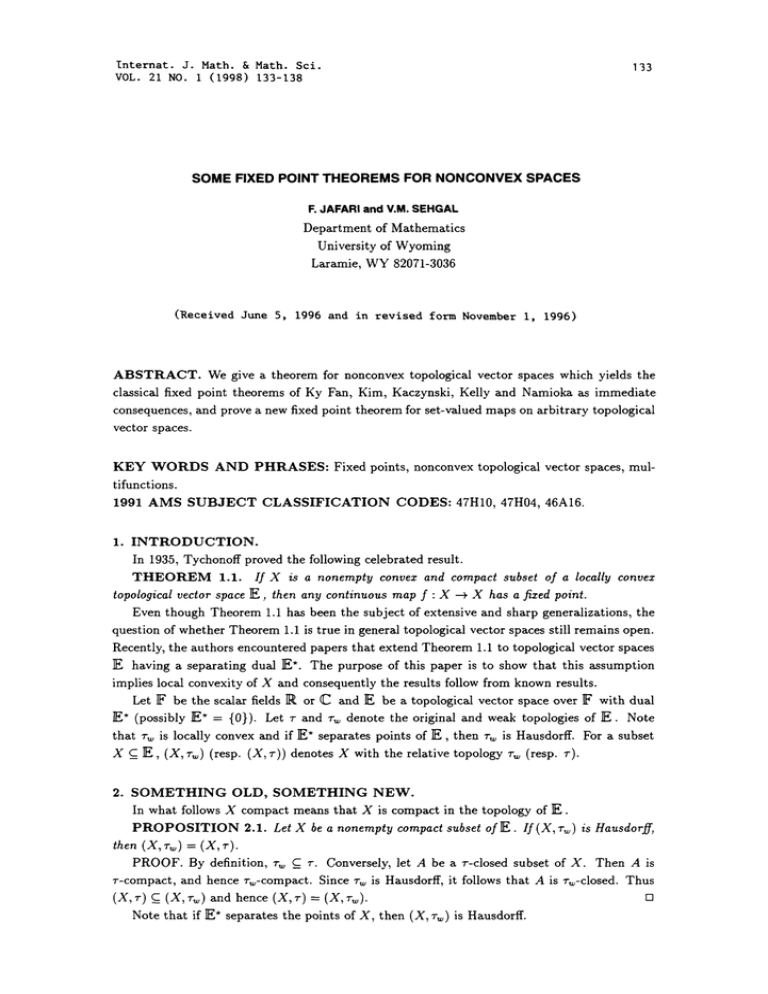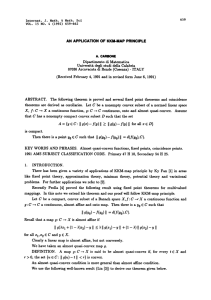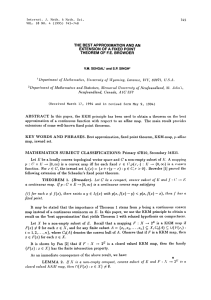Document 10457461
advertisement

Internat. J. Math. & Math. Sci.
VOL. 21 NO.
(1998) 133-138
133
SOME FIXED POINT THEOREMS FOR NONCONVEX SPACES
F. JAFARI and V.M. SEHGAL
Department of Mathematics
University of Wyoming
Laramie, WY 82071-3036
(Received June 5, 1996 and in revised form November i, 1996)
ABSTRACT. We give a theorem for nonconvex topological vector spaces which yields the
classical fixed point theorems of Ky Fan, Kim, Kaczynski, Kelly and Namioka as immediate
consequences, and prove a new fixed point theorem for set-valued maps on arbitrary topological
vector spaces.
KEY WORDS AND PHRASES: Fixed points, nonconvex topological vector spaces, multifunctions.
1991 AMS SUBJECT CLASSIFICATION CODES: 47H10, 47H04, 46A16.
INTRODUCTION.
In 1935, Tychonoff proved the following celebrated result.
THEOREM 1.1. If X is a nonempty convex and compact subset of a locally convex
topological vector space E, then any continuous map f" X -+ X has a fixed point.
Even though Theorem 1.1 has been the subject of extensive and sharp generalizations, the
question of whether Theorem 1.1 is true in general topological vector spaces still remains open.
Recently, the authors encountered papers that extend Theorem 1.1 to topological vector spaces
]E having a separating dual ]E*. The purpose of this paper is to show that this assumption
implies local convexity of X and consequently the results follow from known results.
Let IF be the scalar fields or C and E be a topological vector space over F with dual
(possibly E* {0)). Let T and r denote the original and weak topologies of ]E. Note
that r is locally convex and if ]E* separates points of
then r is Hausdorff. For a subset
X C_ ]E, (X, r,) (resp. (X, r)) denotes X with the relative topology r, (resp. r).
1.
,
*
OLD, SOMETHING NEW.
In what follows X compact means that X is compact in the topology of ]E.
PROPOSITION 2.1. Let X be a nonempty compact subset of
If(X, r) is Hausdorff,
the,,, (x, -,)
(x, -).
PROOF. By definition, ’, _c -. Conversely, let A be a r-closed subset of X. Then A is
--compact, and hence r-compact. Since ’, is Hausdorff, it follows that A is r-closed. Thus
2. SOMETHING
(X, r)
C
(X, r) and hence (X,
Note that if ]* separates the points of X, then (X, r) is Hausdorff.
F. JAFARI AND V. M. SEHGAL
154
Proposition 2.1 provides simple proofs of the following results. Original proofs of these
results make use of partitions of unity or other techniques.
COROLLARY 2.2 (Ky Fan [2]). Let X be a nonempty compact and convex subset of
If IE* separates the points of X, then ever9 continuous map f X --+ X has a fixed poznt.
PROOF. Since
separates the points of X, (X, r) is Hausdorff, hence by Proposition
2.1, (X, r)= (X, r,o), and thus f: (X, r) -+ (X, r)is continuous. Since X is r-compact, by
Theorem 1.1, f has a fixed point.
The following result is a generalization of Corollary 2.2.
COROLLARY 2.3. Let X be a nonempty compact and convex subset
and f X -->
be a continuous function. If IE* separates the points of X, then ezther (a) f has a fixed point,
or (b) there exists :co E X and a v-continuous seminorm p on IE such that 0 < p(zo f(xo))
_..
*
ore
min{p(z- f(zo)) z X}.
PROOF. Since (X,r,o) is Hausdorff, by Proposition 2.1 it follows that (X, r) (X,r).
Since % C_ r, f (X, %) -+ (E, %) is continuous. Since X is r compact, it follows by Ky Fan
[2] that either (a) f has a fixed point, or (b) there exists z0 X and a r-continuous seminorm
p on IE with 0 < p(zo- I(zo))
min{p(z- f(xo)):z X}. Note that a r is continuous
o
seminorm on E is a r-continuous seminorm on E.
As an immediate consequence of the above corollary, we have
COROLLARY 2.4 (Kaczynski [4]). Let X be a nonempty compact convex subset of E
and IE* separate the points of X. If f X --4 E is a continuous function such that for each
z e X, f(z) # z, there ez,st A such that lal < and
x + (I
then
A)f(x) E X,
(i)
f has a fixed point.
PROOF. Assume that f has
no fixed points. Then by Corollary 2.3, there exists z0 E X
and a v-continuous seminorm p on IE satisfying 0 < p(xo-f(xo)) min{p(x-f(zo))" x X}.
By assumption, there exists A with IAI < such that u Sx + (1 $)f(x) X. This implies
that
0 < p(xo f(xo)) <_ p(u f(xo)) [Alp(x0 f(xo)) < p(xo f(xo)),
Hence f has a fixed point.
DEFINITION 2.5. Let X _C ]E. A mapping f X
a contradiction.
-
-
]E is weakly continuous if for every
is continuous.
PROPOSITION 2.6. If f" X --> IF_, is weakly continuous, then f (X, r,) --+ (E, r,) is
continuous.
PROOF. For e > 0 let N(0, e) denote the open neighborhood of 0 of radius e in IF. If V is
a r-basic neighborhood of 0 in IE, then V
f’l,=l(x’)-l(N(0, e,)) for some
z* E
E*, x*(f)’(X, r,o)
IF
z,-.-,x
,=,
and 1,.--,e > 0. Hence f-(V)
f-(x*,)-l(N(O,,)) ,%,(x*,(f))-(N(O,e,))
Thus f (X, r)
(IE, r,,) is continuous.
Let X C IE and z e X. The inward set of X is defined to be
zx(,)
{z e E
z
:+
,(v- :)u s
x,
, > o)
SOME FIXED POINT THEOREMS FOR NONCONVEX SPACES
COROLLARY 2.7 (Kim [6]; also see Singh [7], Theorem 4.53, p. 206). Let X be
and E* separate the points of X. If f" X --> IE
nonempty compact convex subset of
weakly continuous such that for each x X with f(x) 5 x, f(x) 7 closure(Ix(x)), then
a
zs
f
has a fixed point.
PROOF. By Proposition 2.1, (X,r) is
a compact convex subset of the locally convex
and
2.6
by
Proposition
(E,T)
f (X, rw) -+ (E,r,o) is continuous. Since the rclosure(Ix(x)) C_ r-closure(Ix(x)), it follows that for any x # f(x), f(x) r,o-closure(Ix(x)).
[]
The result now follows from Halpren [3].
COROLLARY 2.8 (Kelly-Namioka [5, p. 124]). Let X be a compact convex subset of E.
If/or each nonzero z X- X, there exists z* 6 I* with z*(z) 0 and f" X -+ X is a
continuous mappin9 satisfyzn9
space
f(] a,z,)=
z=l
a,f(z,)
(2)
t--1
each positive integer n, z, 6 X for e {1,2,-", n}, and a, > 0 with ], a,
1, then f
has a fixed poznt.
PROOF. Since E* separates the points of X, (X, r) is Hausdorff, and hence (X,r)
(X, rw). Since (X,r) is compact and f (X,r,o) --+ (X,r)is continuous the result follows
from Theorem 1.1.
REMARK. Note that the condition (:2) is redundant in the present proof.
The heorems of this section readily imply that he Hardy spaces H, 0 < p < 1, have the
fixed point property.
for
-
FIXED POINT THEOREM FOR MULTIFUNCTIONS.
Let 2E denote the family of nonempty subsets of and let f X 2E be a multifunction.
f is upper semicontinuous if for any closed set F C_ ]E, f-l(F) {x q X f(x) N F 0}
is a closed subset of X; f is closed (resp. compact) valued if f(x) is closed (resp. compact)
subset of
for each x X. It is easy to show that if f is closed-valued and if a net x X,
and y
f(x,) with y -+ y0, then the upper semicontinuity of f implies
xo --4 x0
yo f(xo). Furthermore, if f X -+ 2E is upper semicontinuous and compact-valued, then for
any compact set K, the image f(K) (J{f(x)’x K} is compact. For additional properties
of multifunctions see Dugundji and Granas [1] or Smithson [8], for example. The following
proposition, which clearly implies Theorem 11.4 of Dugundji and Granas (see [1], p. 97), is
3. A
,
.
equivalent to their theorem.
-
PROPOSITION 3.1. Let ] be a topological vector space and let X be a nonempty compact
convex subset of
If]E* separates the points of X, and f" X 2 x is a closed-valued, upper
semicontinuous and convex-valued multi/unction, then f has a fixed point.
The following result is motivated by Corollary 2.8.
THEOREM 3.2. Let ]E be a topological vector space and let X be a closed subset of
and f" X --+ 2E be a closed-valued, upper semicontinuous, multi/unction. If
(i) S {x y y 6 f(x),x 6 X} is convex,
(ii) there exists a sequence (x,) C_ X with x,,+x e f(x,) for n 1,2,...,
(iii) f(X) is compact,
then
f
has a fixed point.
]__36
F. JAFARI AND V. M. SEHGAL
.
REMARK. Condition (i) may be replaced by the somewhat more general hypothesis that
=1 zk zk+l E S for every n E N where (z) are as in (ii)
PROOF. We first show that S is a closed subset of Let u be a net in S with uo -+ u0 ]E
in the ’-topology of ]E. Then by definition of S, u xo y where yo f(xo) and x X.
Since (y) _C f(X) and f(X) is compact, it follows that (yo) has a subnet yz
y0 e E. Hence
is
xz uz + Yz -> Uo + yo, by definition. However, (xz) C_ X and X closed. Hence uo + y0 E X.
Now if Xo u0 + y0, x0 X, and since xz -+ x0, yz --+ y0 and y f(x), it follows that
yo f(Zo). Consequently, u0 z0- y0 S and thus S is closed. By the definition of (x) in
(ii), x xn+l E S, and since S is convex, it follows that for any positive integer n,
!
_
that is,
-
k=l
i(,
+,) e
s.
(3)
By (ii), x,+l f(X) for n 1,2,.--, and hence x,- z,+, x,- f(X) which is a compact
subset of ]E. Consequently, for any neighborhood U of 0, xx f(X) C_ kU for some k N.
Thus -(xl f(X)) U for all n >_ k. In particular, (x- f(x,,)) C_ U for all n >_ k. Letting
n
oc, since S is closed, by (3) we have 0 S. Consequently, there is some x0, y0 E f(x0)
r
with x0 y0 0. This implies Xo yo f(xo),
Note that condition (ii) is satisfied if f(x)C X ( for all z X; in particular, if f(z) C_ X.
Further note that I* in Theorem 3.2 may be just {0}. That is to say, no assumption on
separating points of E is made here. The following corollary follows immediately.
COROLLARY 3.3. Let X be a closed convex subset of a topological vector space and
f" X --> X be continuous. If f(X) is compact and f satisfies (2) (see Corollary .8), then f
[]
has a fixed point.
It is interesting to note that the conditions on convexity of S can be replaced by various
other useful conditions on f and X. The remark and note following Theorem 3.2 and Corollary
3.3 provide some such conditions. The following proposition gives a condition on f which is
equivalent to the convexity assumption on S.
PROPOSITION ;3.4. Let X be a closed convex subset of the topological vector space ]
and f X
2E be a closed-valued, upper semicontinuous, multifunction such that f(X) is
compact. Then S {x y y f(z),x X} is convez if and only if
*
-
1/2f(x) + f(y) C_f(x + y)
vx, ye x.
(4)
PROOF. Suppose S is convex. Then for z,z2
S, 7zl + z2 S. In particular, if
z,
x,- y,, with x, X, and y, f(x,) for
1,2, we have (xl + zz)- 1/2(yx + y) S.
That is, 7(y + y)
f((x + x)). Now, since this holds for every choice of y, f(x,),
E {1,2}, (4) readily follows. Conversely, suppose f satisfies (4), and let z,z2, x,x,yx,y
be chosen as above. Then since S is closed (by proof of Theorem 3.2), to show S is convex it
is sufficient to show S is midpoint convex. Since z + z
7(xl + z_)- (y + y), by (4),
21-(yl-" Y2) e f(1/2(X, + X2)) and thus 1/2zx + iz= S. Hence S is midpoint convex and thus
convex.
[]
SOME FIXED POINT THEOREMS FOR NONCONVEX SPACES
137
Note that a multifunction is midpoint convex if f(1 + y) C_ 1/2f(x) + 1/2f(y) and f is
midpoint concave if it satisfies (4). We conclude with a simple example.
EXAMPLE 3.i. Let X [0, 1] C_ I, : [0, cxz[- [0, oc[ be a nondecreasing, continuous
function such that (o(x)+ (y)) < (1/2(x + y)) for all x,y e [0, cxz[. For example, let (x)=
log(x + 1). Define f(x)= [0, T(x)] for all z e X. Then fX [0,p(1)] is compact, and clearly
f is a closed-valued and upper semicontinuous multifunction. By the hypothesis on for
x, y E X,
f(x) + -f(y)
[0, ((x) + (y))]
_
x
,
[0, ((x + y))]
hence by Proposition 3.4, S is convex. Since f(x)N X
has a fixed point.
f(l(x +y))
# 0 for any x E X, by Theorem 3.2, f
ACKNOWLEDGEMENT. The authors wish to thank Professor S. P. Singh for providing
them with a working draft of his notes on partitions of unity and for some references herein
cited.
REFERENCES
[1] DUGUNDJI, J. and GRANAS, A., Fixed Point Theory, Vo. 1, Polish Scientific
Publishers, Warsaw, 1982.
[2] FAN, K., Sur un thk:rme minimax, C. R. Acad. Sci. Paris 259 (1964), 39253928.
[3] HALPREN, B.R.,
Fixed point theorems for set-valued maps in infinite dimensional spaces, Math. Ann. 189 (1970), 87-89.
[4] KACZYNSKI, T., Quelques thorme de
points fixes dans des espaces ayant
suffisamment de fonctionnelles linaires, C. R. Acad. Sci. Paros Sdr. I Math.
296 (1983), 873-874.
and NAMIOKA, I., Linear Topological Spaces, D. Van Nostrand
Company, Inc., Princeton, New Jersey, 1963.
[5] KELLY, J.
[6] KIM, S.Y., Ph.D. Thesis, Seoul National University, Korea.
[7] SINGH, S.P., Private communications (1995).
[8] SMITHSON, R.E., Multifunctions, Nieuw Archief voor Wiskunde 3 (1972),
53.
31-






